6 Best Mid Tower Case Picks for 2020
The computer case provides a home for all of your precious components, so choosing the right one should never be an afterthought. After all, you wouldn’t want to splurge on a top-of-the-line graphics card and CPU only to have them sputter under excessive heat.
Mid tower cases are the optimum solution for the vast majority of users. They’re spacious enough for differently-sized components and have room left over for proper cable management and airflow. They support various motherboard sizes and work well with either multi-fan setups or water-cooled solutions to keep everything running smoothly even when the computer is under heavy load. A worthy case needs to keep noise down to a minimum, and having it look good wouldn’t hurt either.
Here are the six best mid tower case picks for your PC building pleasure. The models we’ve reviewed aren’t overpriced, allow for lots of customization, and will give your build enough room to breathe. Pick one out and lay a solid foundation for your dream computer.
| Budget |
|---|
 |
| Antec P82 Flow |
| 4.1/5.0 |
| Weight: 17.2 lbs. |
| Dimensions: 18.9 x 8.5 x 17.9 in. |
| Comes with four pre-installed fans. |
| Check Newegg |
| Best Value |
|---|
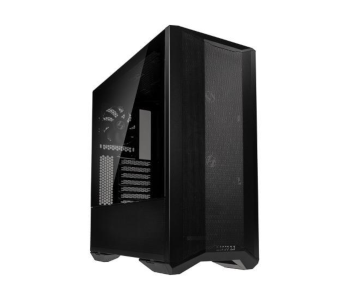 |
| LIAN LI Lancool 2 Mesh |
| 4.7/5.0 |
| Weight: 28.6 lbs. |
| Dimensions: 18.8 x 9 x 19.5 in. |
| It has an excellent cable management. |
| Check Amazon |
| Top Pick |
|---|
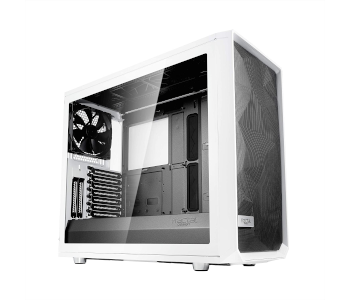 |
| Fractal Design Meshify S2 |
| 4.8/5.0 |
| Weight: 23.2 lbs. |
| Dimensions: 21.2 x 9.2 x 18.3 in. |
| Outstanding airflow and temperature management. |
| Check Amazon |
Mid Tower Cases Comparison Table
| Image | Product | Overall Rating | Build quality & aesthetics | Ports & cable management | Cooling | Price |
|---|---|---|---|---|---|---|
 | Fractal Design Meshify S2 | 4.8 | 4.7 | 4.9 | 4.8 | Check Price |
 | LIAN LI Lancool 2 Mesh | 4.7 | 4.6 | 4.7 | 4.7 | Check Price |
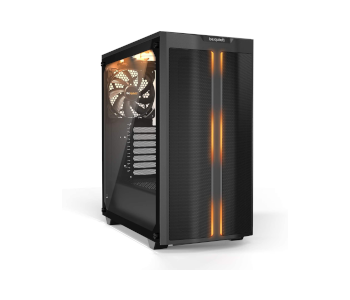 | Be quiet! Pure Base 500DX | 4.5 | 4.5 | 4.6 | 4.5 | Check Price |
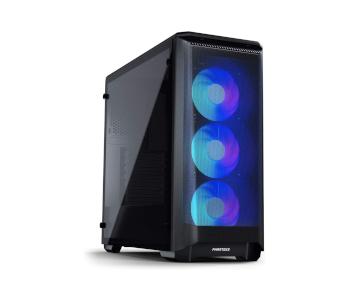 | Phanteks Eclipse P400A Digital | 4.3 | 4.3 | 4.3 | 4.4 | Check Price |
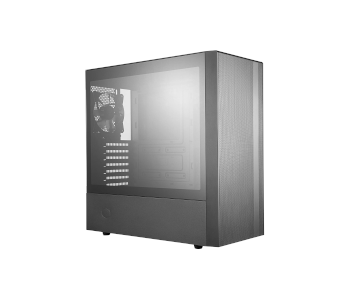 | Cooler Master MasterBox NR600 | 4.2 | 4.1 | 4.3 | 4.3 | Check Price |
 | Antec P82 Flow | 4.1 | 3.9 | 4.2 | 4.2 | Check Price |
1. Best Overall – Fractal Design Meshify S2
Editor’s Rating: 4.8/5
The most powerful RTX cards and 8-core processors require lots of space and cooling not to run hot, and that’s what the Meshify S2 by Fractal design provides in droves. It’s a large mid tower case with an impressive array of options, whether you require liquid cooling or a multitude of fans. It’s neither light nor cheap, but your components and ears will be thankful for getting it.
Overview of Features
It’s nice to see that the Meshify S2 has opted for a serious look in the age of RGB everything as the Meshify S2 is minimalistic and imposing. That’s not to say it’s badly designed; just look at its front mesh’s odd angles, and you’ll be instantly impressed. A tempered glass side panel completes its aesthetics and is tinted with varying degrees of severity based on your chosen color combination.
Cooling management is by far the best thing about the Meshify S2. It ships with three Dynamic X2 GP-14 fans and has room for six more, letting you optimize airflow while keeping noise to a minimum. Its top can be removed without touching the side panels and has a mesh and lots of room for either three 140mm fans or liquid cooling radiators as long as 420mm. You can place additional fans on the bottom as well and control all of them through a hub found at the back of the motherboard.
The Meshify S2 is spacious for a mid tower. This lets you install aftermarket CPU coolers and three-fanned GPU monstrosities with lots of room left over for cables. It supports long power supplies too, although you’ll need to slide these in from the back and can’t tilt them during a build.
Cable management is another point in the Meshify S2’s favor. There are five grommeted pass-throughs on the motherboard & PSU that help guide the cables without tangling. The case’s back offers plenty of driving bays for SSD installation with guides and straps that keep cables tidy.
It comes as no surprise that the Meshify S2 excels at keeping temperatures down. The three stock fans keep less demanding hardware from overheating, while the case’s open-ended configuration means you can tackle thermal issues by merely throwing more air at them or installing a liquid cooler. It’s also one of the quietest cases we’ve tested.
What’s Bad About It?
Pointing out negatives about the Meshify S2 requires nitpicking, which is a testament to its quality. The case is made from steel and is heavy for its size. It’s an expensive case, and prices vary considerably depending on the color.
| Tech Specs |
|---|
| Dimensions: 21.2 x 9.2 x 18.3 in. |
| Weight: 23.2 lbs. |
| Supported motherboards: Mini ITX – E-ATX |
| Expansion slots: 7+2 |
| Front connections: 2x USB 3.0, 1x USB Type-C, 3.5 mm audio & mic |
| Max. CPU cooler height: 7.3 in. |
| Max. GPU length: 17.3 in. |
| Internal bays: 3x 3.5-inch, 2x 2.5-inch |
| Installed fans: 2x 140 mm front, 1x 140mm rear |
| Pros |
|---|
| Outstanding airflow and temperature management |
| Lots of room for bulky components |
| Tidy and organized |
| Cool-looking front panel |
| Cons |
|---|
| Pricey |
| Heavy |
2. Best Value – LIAN LI Lancool 2 Mesh
Editor’s Rating: 4.7/5
Lian Li broke its tradition of premium-quality aluminum cases when it delivered the first Lancool. The New & upgraded Mesh version combines a steel case with tempered glass, ingenious cable management, and a straightforward installation process that nevertheless ensures all your components are securely in place. It also has some of the best thermals and airflow optimization that puts more expensive cases to shame.
You can get the Lancool 2 Mesh in several versions. We’re reviewing the basic black one without RGB fans, but there’s also an RGB model with three 120mm fans in the front you can set up to glow in millions of colors. You’ll have to pay extra for that feature, though.
Overview of Features
Everything about the Lancool 2 Mesh has been designed to allow ease of access while shielding vital components from harm. You’ll find the mesh from its name on the front panel. It allows for better air intake and improves cooling. There’s no filter in front of the two 140mm fans, but diligent users won’t need one since the case is simple to clean.
You can access the chassis’ front and sides by tugging at magnets that keep the tempered glass panels and mesh in place. The panels flip backward and slide off of their hinges when you need to remove them. You have to open the PSU hatch before doing so, which reveals space for a large power supply and several 2.5-inch drive bays. These slide along rails to either make room for a bigger PSU or for radiators in the front.
The Lancool 2 Mesh supports motherboards ranging from Mini ITX to E-ATX, and you can install them without laying the case on the ground. Cable management is superb thanks to several panels that block your handiwork off and make everything look seamless even though there’s a glass panel on the right.
You get three PWM fans and can install more on the top, back, or under the PSU housing as well as use radiators. You might not need to since stock fans already deliver superb airflow and keep the PC cool. Noise isn’t a concern either since the fans have a low idle RPM and don’t get loud even if they’re on full blast.
What We Didn’t Like
The Lancool 2 Mesh doesn’t have USB Type-C, or rather, you can install an extra slot on its I/O panel if you pay extra. You can install extra fans on the PSU shroud if you need them, but that hinders access to the motherboard’s bottom part.
| Tech Specs |
|---|
| Dimensions: 18.8 x 9 x 19.5 in. |
| Weight: 28.6 lbs. |
| Supported motherboards: Mini ITX – E-ATX |
| Expansion slots: 7 |
| Front connections: 2x USB 3.0, 1x USB Type-C, 3.5 mm audio/mic combo |
| Max. CPU cooler height: 6.9 in. |
| Max. GPU length: 15.1 in. |
| Internal bays: 3x 3.5-inch, 4x 2.5-inch |
| Installed fans: 2x 140 mm front, 1x 120mm rear |
| Pros |
|---|
| Easy access to internal components thanks to magnets |
| Excellent cable management |
| Outstanding airflow & cooling |
| Good noise levels |
| Cons |
|---|
| USB Type-C port costs extra |
| Installing additional fans on CPU housing limits motherboard access |
3. Be quiet! Pure Base 500DX
Editor’s Rating: 4.5/5
Be quiet! built its reputation on creating computer cases that make silent operation their number one priority. While there’s a niche market for enthusiasts who need absolute silence while working or gaming, the Pure Base 500DX is bound to capture a broader audience. There’s something for everyone – customizable RGB strips, easy component installation, quality fans, and excellent thermals management come together to make an unusual but well-performing chassis.
Overview of Features
The Pure Base 500DX is a modern-looking case with a prominent front mesh ad a tempered glass side panel. Unlike the Lancool 2, it has filters in front of the mesh and under the PSU housing. You can get to the front one by yanking off the front panel while the bottom one slides outward for easy cleaning. The panel is held in place by thumbscrews and can be removed in seconds.
There are two LED strips in the front, and one runs along the inside of the case. A button on the top I/O panel lets you cycle through multiple presets and customize their appearance to your liking. You’ll find audio & mic ports along with USB Type-A and USB Type-C ports.
The PSU shroud is perforated for better airflow and has several holes to make routing cables to the graphics card more convenient. Speaking of cables, several guides and Velcro ties in the back will help with management. There’s also ample room between the back panel and the motherboard’s rear for their placement.
The Pure Base 500DX brings you up to speed with component installation as the motherboard standoffs are already in place, and mounting the PSU is a matter of sliding it into place from the back. You’ll find most of its drive bays inside the shroud while two are close to the front fan.
The Pure Base 500DX is an excellent performer when it comes to thermals. Its dust filter doesn’t obstruct airflow, and the three Pure Wing 2 fans cycle air through the case reliably. There’s also lots of room for expansion since the case supports 360mm and 240mm radiators along with more 120 or 140mm fans in the front and on top.
What We Didn’t Like
Contrary to its manufacturer’s name, the Pure Base 500DX isn’t a quiet case during high loads. It would have also benefited from another USB Type-A port in the front.
| Tech Specs |
|---|
| Dimensions: 18.3 x 9.1 x 17.7 in. |
| Weight: 17.6 lbs. |
| Supported motherboards: Mini ITX – ATX |
| Expansion slots: 7 |
| Front connections: 1x USB 3.0, 1x USB Type-C, 3.5 mm audio & mic |
| Max. CPU cooler height: 7.5 in. |
| Max. GPU length: 14.5 in. |
| Internal bays: 2x 3.5-inch, 5x 2.5-inch |
| Installed fans: 1x 140 mm front, rear, top |
| Pros |
|---|
| Lots of straps and cable guides for better management |
| Great airflow and thermals |
| Customizable LED strips |
| Filters keep dust at bay without affecting fan performance |
| Cons |
|---|
| Single USB Type-A port |
| Loud |
4. Phanteks Eclipse P400A Digital
Editor’s Rating: 4.3/5
RGB has become a staple of many gaming PCs, and the Eclipse P400A Digital by Phanteks is an excellent choice if you want to combine it with optimized cooling. The chassis sports three 120mm RGB fans you can conveniently manage with a controller on the I/O panel. There’s room for many more fans as well as an ATX motherboard and a sizeable GPU.
Overview of Features
The Eclipse P400A Digital would be plain-looking, were it not for its LED fans. They improve its aesthetics and can turn the case from tastefully-lit to gaudy as you fiddle with the controller. The fans are placed behind a mesh with no connections to the I/O panel, meaning you can completely remove and thoroughly wash it if there’s too much dust buildup. You don’t get a filter, which is just as well as that would impede airflow and increase noise.
The case’s interior is precision-machined and provides enough cutouts & grommets to accommodate as many cables as you need. You’ll find several Velcro straps secured with a screw in the back for tighter cable control. The perforated PSU housing lets you position the power supply with its fan facing either up or down. There are no dedicated cable holes for the GPU, but getting power to it isn’t a problem.
The Eclipse P400A Digital arrives with three fans, all of them in the front. You can buy one more 120mm model for the back and two 140mm ones for its roof. The case has no trouble accommodating a 360mm radiator in the front and a 120m one in the rear either.
Installing a build is straightforward since the cutouts serve as intuitive placement markers for the motherboard while the PSU chassis takes care of power and storage. The only time you might encounter space issues is if you install 140mm fans on top first and proceed to run cables after that. Do the opposite, and you should be fine.
Are There Drawbacks?
The Eclipse P400A Digital’s I/O panel lacks a USB-C port. There’s a non-RGB version of the case that has a controller that handles fan speed instead of RGB. The controller is absent on the more expensive model, which makes little sense both in terms of user experience and production cost.
| Tech Specs |
|---|
| Dimensions: 18.5 x 8.3 x 18.3 in. |
| Weight: 15.4 lbs. |
| Supported motherboards: ITX – ATX |
| Expansion slots: 7 |
| Front connections: 2x USB 3.0, 3.5 mm audio & mic |
| Max. CPU cooler height: 6.3 in. |
| Max. GPU length: 14.5 in. |
| Internal bays: 2x 3.5-inch, 2x 2.5-inch |
| Installed fans: 3x 120 mm front |
| Pros |
|---|
| Excellent RGB fans |
| Removable front panel promotes airflow |
| Lots of grommets and cutouts improve cable routing |
| Spacious interior with intuitive component layout |
| Cons |
|---|
| No USB-C port |
| RGB version lacks fan speed controller and vice versa |
5. Cooler Master MasterBox NR600
Editor’s Rating: 4.2/5
Are you looking for a no-frills mid tower with admirable cooling and noise dampening that won’t break the bank? Cooler Master’s MasterBox NR600 is a no-brainer in that case as it forgoes flash and presentation for results. There’s lots of room in its interior despite the case’s relatively small overall size. You can expand its fan set and customize airflow to your liking and easily install or swap out components.
Overview of Features
The MasterBox NR600 looks simple, but that doesn’t mean it’s not a looker. It’s a subdued, rectangular case that doesn’t look out of place in an office. The front panel has a fine mesh that acts as a filter. You can find a dedicated filtration layer on top along with power & reset buttons, two USB 3.0 ports, and a single headphone jack. There’s another filter in front of the PSU, which you won’t be able to remove unless you put the MasterBox NR600 on its side.
Even though it’s affordable, the MasterBox NR600 comes with a tinted glass panel. The panel has a large metal rim with holes for thumb screws, which helps protect the glass when you’re removing it. Seven expansion slots offer plenty of room for two graphics cards, while the MasterBox NR600’s interior is big enough to house an AIO without cramping the components. There’s less room behind the motherboard than we’d like, but a generous supply of ties and grommets keeps cables in line.
You’ll appreciate the MasterBox NR600’s layout if you need a lot of storage space. There’s room for four 3.5-inch and five 2.5-inch drives spaced out between the inside of the PSU tunnel and the back of the motherboard.
The MasterBox NR600’s stock setup provides decent airflow and won’t let temperatures get out of hand. However, supplementing it with just one more intake fan improves thermals considerably without making a ruckus. Noise control is one of the MasterBox NR600’s best features since its fans don’t exceed 30dB when idle.
What‘s Bad About It?
The MasterBox NR600 is another case that lacks a USB Type-C port, which makes it less futureproof than some of its more expensive rivals. The single headphone jack is a combination audio & mic input, so you won’t be able to use the microphone if your headphones have a separate cable for it.
| Tech Specs |
|---|
| Dimensions: 18.6 x 8.2 x 18.8 in. |
| Weight: 14.5 lbs. |
| Supported motherboards: Mini ITX – ATX |
| Expansion slots: 7 |
| Front connections: 2x USB 3.0, 1x headset jack |
| Max. CPU cooler height: 6.5 in. |
| Max. GPU length: 16.1 in. |
| Internal bays: 4x 3.5-inch, 5x 2.5-inch |
| Installed fans: 1x 120 mm front and rear |
| Pros |
|---|
| Silent operation while idle |
| Has room for lots of drives |
| Professional appearance that can be customized nevertheless |
| Spacious interior accommodates long GPUs |
| Cons |
|---|
| No USB-C port |
| Single headphone jack might be problematic |
6. Best Budget Option – Antec P82 Flow
Editor’s Rating: 4.1/5
Antec’s budget cases are a testament to ingenuity as they manage to offer a lot of bang for your buck without skimping on build quality. Take the P82 Flow, a mid tower that comes with a whopping four fans pre-installed. They aren’t cheap or flimsy either, so you can look forward to cool gaming or productivity with tolerable noise levels. The case isn’t flashy, but its simple design and clean interior allow for a tidy build.
Overview of Features
The P82 Flow is a simple-looking case with lots of tiny design decisions that add up to create an appealing whole. For example, its front panel has a one-sided chamfer that breaks up the monotony and makes it look futuristic. The I/O is located entirely on the left panel, beside the glass sheet that fits flush with the case without any screws towards the front.
Antec generously supplies the P82 Flow with four fans, 140mm ones at that! Three of them are in front while the last one propels hot air out from the case. There’s room for two more 140mm fans on top, or you can use three either there or in the front. You’ll find protective meshes on top and under the PSU area, both of which are easy to remove and clean.
We wouldn’t say that Antec cut corners with the P82 Flow, but taking a closer look at the interior reveals that it was built without flexibility in mind. There’s exactly enough room for an ATX board and associated wire connections.
The tray found inside the PSU shroud can house two 3.5-inch drives or manage a 360mm radiator while there’s room for several SSDs behind the motherboard. The seven expansion slots take graphics cards that are 15 inches long or less, and you even get covers that prevent dust buildup if you’ve accidentally removed the ones that are welded on,
The fact that the P82 Flow has excellent thermals comes as no surprise. Its four fans keep the air pressure inside the case positive and eject hot air out before it can impact performance. The case isn’t the most silent performer while idle, but noise improves relative to similarly-priced models under load.
Are There Drawbacks?
The P82 Flow’s tight fit might cause several issues during setup. You won’t be able to manage cables as efficiently and have to forget about putting in elaborate cooling systems as there’s no room for them. The steel the P82 Flow is made from is thin. You’ll want to be careful when installing or replacing components as straining it too much might cause bending.
| Tech Specs |
|---|
| Dimensions: 18.9 x 8.5 x 17.9 in. |
| Weight: 17.2 lbs. |
| Supported motherboards: ITX – ATX |
| Expansion slots: 7 |
| Front connections: 2x USB 3.0, 3.5 mm audio & mic |
| Max. CPU cooler height: 7 in. |
| Max. GPU length: 15 in. |
| Internal bays: 2x 3.5-inch, 2x 2.5-inch |
| Installed fans: 3x 140 mm front, 1x 140mm rear |
| Pros |
|---|
| Comes with four pre-installed fans |
| Excellent value for the money |
| Easy to keep clean |
| Great thermals |
| Cons |
|---|
| Not a lot of interior room to work with |
| Thin steel constructions |
Contents
- Mid Tower Cases Comparison Table
- 1. Best Overall – Fractal Design Meshify S2
- Overview of Features
- What’s Bad About It?
- 2. Best Value – LIAN LI Lancool 2 Mesh
- Overview of Features
- What We Didn’t Like
- 3. Be quiet! Pure Base 500DX
- Overview of Features
- What We Didn’t Like
- 4. Phanteks Eclipse P400A Digital
- Overview of Features
- Are There Drawbacks?
- 5. Cooler Master MasterBox NR600
- Overview of Features
- What‘s Bad About It?
- 6. Best Budget Option – Antec P82 Flow
- Overview of Features
- Are There Drawbacks?

